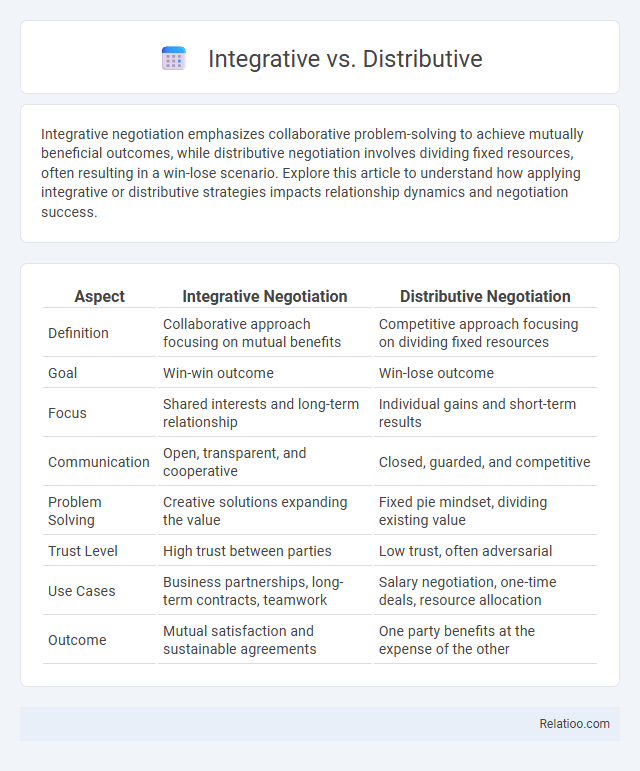Integrative negotiation emphasizes collaborative problem-solving to achieve mutually beneficial outcomes, while distributive negotiation involves dividing fixed resources, often resulting in a win-lose scenario. Explore this article to understand how applying integrative or distributive strategies impacts relationship dynamics and negotiation success.
Table of Comparison
| Aspect | Integrative Negotiation | Distributive Negotiation |
|---|---|---|
| Definition | Collaborative approach focusing on mutual benefits | Competitive approach focusing on dividing fixed resources |
| Goal | Win-win outcome | Win-lose outcome |
| Focus | Shared interests and long-term relationship | Individual gains and short-term results |
| Communication | Open, transparent, and cooperative | Closed, guarded, and competitive |
| Problem Solving | Creative solutions expanding the value | Fixed pie mindset, dividing existing value |
| Trust Level | High trust between parties | Low trust, often adversarial |
| Use Cases | Business partnerships, long-term contracts, teamwork | Salary negotiation, one-time deals, resource allocation |
| Outcome | Mutual satisfaction and sustainable agreements | One party benefits at the expense of the other |
Understanding Integrative and Distributive Negotiation
Integrative negotiation focuses on creating value and finding win-win solutions by addressing the underlying interests of all parties, leading to collaborative outcomes that benefit You and others involved. Distributive negotiation, on the other hand, involves dividing a fixed amount of resources, often resulting in a competitive, win-lose scenario where each party aims to maximize their individual gain. Understanding the distinct strategies and goals of integrative and distributive negotiation is essential for effectively navigating conflicts and achieving desired results.
Key Principles of Integrative Negotiation
Integrative negotiation focuses on creating win-win solutions by emphasizing collaboration, open communication, and the identification of shared interests between parties. Key principles include expanding the available options before deciding, understanding underlying needs rather than fixed positions, and building trust to facilitate joint problem-solving. This approach contrasts with distributive negotiation's zero-sum mindset and mutuality's balanced exchange by prioritizing value creation and long-term relationship building.
Core Elements of Distributive Negotiation
Distributive negotiation centers on the core elements of a fixed resource or "pie," where parties compete to claim the largest share, often resulting in a win-lose scenario. Your goal in distributive negotiation involves clear understanding of reservation points, target prices, and BATNA (Best Alternative to a Negotiated Agreement) to maximize your outcome. Effective use of tactics like making the first offer and leveraging information asymmetry can significantly influence the negotiation's success within this competitive framework.
Major Differences Between Integrative and Distributive Approaches
Integrative negotiation focuses on collaboration and creating win-win solutions by addressing the underlying interests of all parties, whereas distributive negotiation centers on dividing a fixed resource, resulting in win-lose outcomes. Integrative approaches emphasize trust-building, information sharing, and expanding options to maximize joint value, contrasting with distributive tactics that rely on competitive strategies, limited disclosure, and claiming the largest possible share. Understanding these major differences is crucial for applying the appropriate strategy based on negotiation goals and relationship dynamics.
When to Use Integrative Negotiation Strategies
Integrative negotiation strategies are best used when parties seek to create value and collaborate on mutually beneficial solutions, especially in long-term relationships or complex issues requiring joint problem-solving. This approach emphasizes open communication, trust-building, and understanding underlying interests to expand the available options beyond zero-sum outcomes typical in distributive bargaining. Integrative strategies are particularly effective in scenarios where preserving relationships and achieving win-win results provide greater long-term gains than simply dividing fixed resources.
Situations Ideal for Distributive Negotiation
Distributive negotiation is ideal in situations where resources are fixed and parties compete for the largest share, such as price bargaining or one-time sales agreements. Your focus should be on maximizing your gains when the negotiation is a zero-sum game with limited room for collaboration or trust. This approach suits scenarios with clear, conflicting interests and no ongoing relationship between parties.
Advantages of Integrative Negotiation Tactics
Integrative negotiation tactics emphasize collaboration and win-win solutions that expand the value for all parties, leading to long-term relationships and higher satisfaction. These tactics prioritize understanding interests rather than positions, enabling creative problem-solving that addresses underlying needs. By fostering trust and open communication, your negotiations are more likely to result in sustainable agreements and mutual gains.
Disadvantages of Distributive Negotiation Methods
Distributive negotiation methods often result in a win-lose outcome, where one party's gain is directly at the expense of the other, leading to damaged relationships and reduced trust. This approach encourages competitive behavior rather than collaboration, which can limit long-term value creation and hinder future partnerships. The focus on short-term gains also increases the risk of impasse and may cause parties to overlook mutually beneficial solutions.
Integrating Both Approaches for Negotiation Success
Integrative negotiation focuses on collaboration and creating win-win solutions by addressing the underlying interests of all parties, while distributive negotiation centers on dividing fixed resources, often leading to a win-lose outcome. Mutuality emphasizes building trust and long-term relationships, enhancing cooperation and mutual gains over time. You can achieve negotiation success by effectively integrating both integrative and distributive approaches, balancing cooperative problem-solving with strategic value claiming.
Real-World Examples: Integrative vs Distributive Negotiation
Integrative negotiation involves collaboration to find win-win solutions, exemplified when two companies partner to co-develop a product, sharing resources and profits to maximize joint value. Distributive negotiation is competitive and zero-sum, such as haggling price for a used car where one party's gain equals the other's loss. Your ability to recognize when to apply these strategies impacts negotiation outcomes, balancing cooperation and competition effectively in real-world business scenarios.

Infographic: Integrative vs Distributive
 relatioo.com
relatioo.com